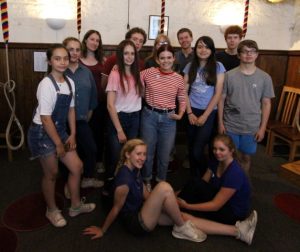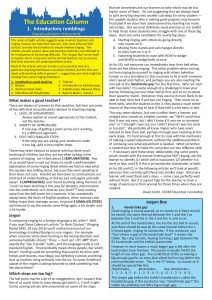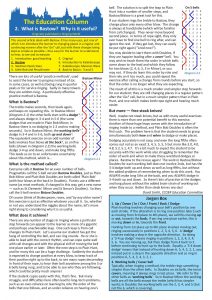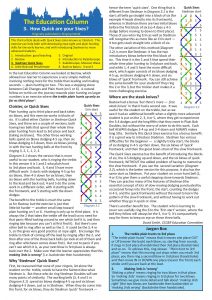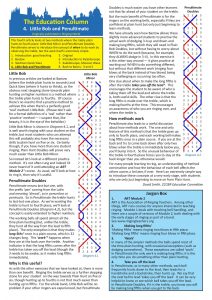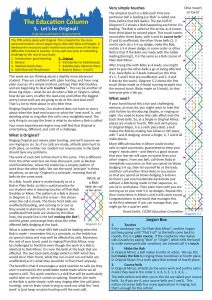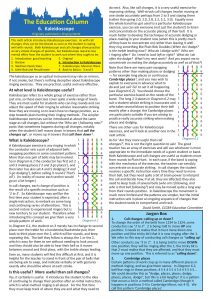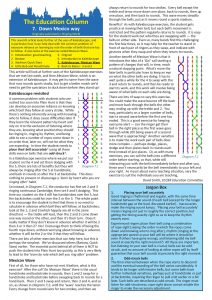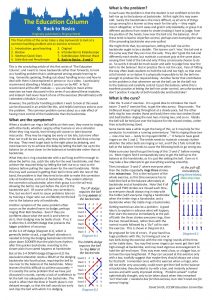The Central Council is the largest publisher of ringing books, all of which can be found in the Shop on this website. The Council has also now published the following works as eBooks for reading online and on mobile devices. These make use of the online format to includes links to other content, videos and other resources.
Calling it Round – Bryn Reinstadler, 2021
This eBook is aimed at any ringer who would like to get more experience at calling and conducting, There is a particular emphasis on being able to call from any bell in order to make it as inclusive is possible, and get away from the perception that calling and conducting is the preserve of those who ring heavier bells. The eBook goes as far as transposing coursing orders and conducting on handbells.
Bryn is herself a relatively recent learner (2017) in North America , but learned to call and conduct on tower and handbells. This book is therefore written from the perspective of someone new to the skill, and whose experience of calling and conducting comes from ringing lighter bells.
While Calling it Round is already a complete work, Bryn intends to add further chapters in due course.
Devon Call Changes – Simon Linford, 2022
This is an eBook on learning to ring call changes in the style practiced in the South West of England. It is however written from the perspective of an experienced method ringer who is introducing closed handstroke lead call change ringing into the repertoire of a method ringing band, and sees the value of doing do.
Simon started writing Devon Call Changes during his term as President of the Central Council, in response to one of the Council’s Strategic Priorities that method ringing does not need to be target of every ringer. In method ringing circles, call change ringing is often seen as just an exercise for the learners and something that is a steppingstone to ‘greater things’ however in this eBook Simon hopes to show how it is a fulfilling target in itself, with different rewards.
Unlike Calling It Round, Devon Call Changes is not a complete work as it is being written in parallel with Simon going through is own Devon call change ‘journey’. It should however give a starting point for other bands who want to give this style of ringing a try, but who don’t quite now how to start.
This online document is aimed at those responsible for keeping a bell installation in good order. It aims to describe checks that should be carried out to identify any problems, offers advice on maintenance tasks and when further expert advice or assistance may be required.
This on-line document is aimed at the person responsible for running a tower whether that be an established tower captain, one new to the job or one considering the role. The document aims to describe the statutory and legal requirements, advice on how to make a tower an enjoyable place to be and provide hints on running a tower.
This document provides information and advice on all aspects of a running a bell project, including planning the scope of the project, getting specialist advice, building a project team, fund raising, formalities, and many others.
Other online publications
In addition, a number of older Council publications are now available as free downloads.
The Beginners Guide to Change Ringing on Handbells
This is a series of regular articles on teaching and learning published in The Ringing World. Most were written by John Harrison, then chairman of the Education Committee.
The collected articles are available in book form from the Central Council Publications Shop:
The Learning Curve, Volume 1: 1999-2001
The Learning Curve, Volume 2: 2002-2003
The Learning Curve, Volume 3: 2004-2005
The Learning Curve, Volume 4: 2006-2007
By arrangement with The Ringing World and Central Council Publications, each of the 102 articles is available as an individual PDF file . You are free to download and use them for training purposes.
You can download any article either by clicking on the link in the list of volumes and chapters below, or alternatively via the online index which provides links to articles based on the topics covered.
| Vol-Chapter | Published | Title |
|---|---|---|
| 2-01 | January 2002 | Hands and arms |
| 2-02 | February 2002 | Intermediate methods |
| 2-03 | March 2002 | Why learn Grandsire? |
| 2-04 | April 2002 | Observation |
| 2-05 | May 2002 | Does size matter? |
| 2-06 | June 2002 | Visualising methods |
| 2-07 | July 2002 | Chiming |
| 2-08 | August 2002 | Coils and things |
| 2-09 | September 2002 | More about coils |
| 2-10 | October 2002 | Music to the ears |
| 2-11 | November 2002 | Go … |
| 2-12 | December 2002 | Muscle memory and flying |
| 2-13 | January 2003 | The long and short of it |
| 2-14 | February 2003 | Go … again |
| 2-15 | March 2003 | Leading |
| 2-16 | April 2003 | Mother of invention |
| 2-17 | May 2003 | Speed |
| 2-18 | June 2003 | From the same hymn sheet |
| 2-19 | July 2003 | Motor learning |
| 2-20 | August 2003 | More hymn sheets |
| 2-21 | September 2003 | Perfection versus holism |
| 2-22 | October 2003 | Simulators |
| 2-23 | November 2003 | More invention |
| 2-24 | December 2003 | It depends how you look at it |
| Vol-Chapter | Published | Title |
|---|---|---|
| 3-01 | January 2004 | Conducting and coursing order – 1 |
| 3-02 | February 2004 | Conducting and coursing order – 2 |
| 3-03 | March 2004 | When things go wrong |
| 3-04 | April 2004 | Place notation |
| 3-05 | May 2004 | Steady as she goes |
| 3-06 | June 2004 | Minimus is good for you |
| 3-07 | July 2004 | Something original |
| 3-08 | August 2004 | What if …? |
| 3-09 | September 2004 | How fast should we go? |
| 3-10 | October 2004 | Beyond the blue line |
| 3-11 | November 2004 | Know your instrument – 1 |
| 3-12 | December 2004 | All roads lead to Rome |
| 3-13 | January 2005 | Know your instrument – 2 |
| 3-14 | February 2005 | Ringing and numbers |
| 3-15 | March 2005 | Once more with feeling |
| 3-16 | April 2005 | Knowing and doing |
| 3-17 | May 2005 | Fitting together |
| 3-18 | June 2005 | Taking the lead |
| 3-19 | July 2005 | Listen to the music |
| 3-20 | August 2005 | Grids |
| 3-21 | September 2005 | Bob Doubles – The Holy Grail? |
| 3-22 | October 2005 | Helpful bits of structure |
| 3-23 | November 2005 | I got rhythm |
| 3-24 | December 2005 | Is there another way? |
| Vol-Chapter | Published | Title |
|---|---|---|
| 4-01 | January 2006 | Conduct Grandsire Doubles – 1 |
| 4-02 | February 2006 | Conduct Grandsire Doubles – 2 |
| 4-03 | March 2006 | Know your instrument – 3 |
| 4-04 | April 2006 | Learning all eleven |
| 4-05 | May 2006 | Quarters are good for you |
| 4-06 | June 2006 | More helpful structure |
| 4-07 | July 2006 | Judging |
| 4-08 | August 2006 | Eyes down for a full house |
| 4-09 | September 2006 | Viewed from the treble |
| 4-10 | October 2006 | Double Oxford |
| 4-11 | November 2006 | Calling quarter peals |
| 4-12 | December 2006 | Learning to hunt |
| 4-13 | January 2007 | Ears to hear |
| 4-14 | February 2007 | Singles in Stedman Doubles |
| 4-15 | March 2007 | Yorkshire on higher numbers |
| 4-16 | April 2007 | Double Norwich |
| 4-17 | May 2007 | Up and down |
| 4-18 | June 2007 | Pieces of eight? |
| 4-19 | July 2007 | Rope movement |
| 4-20 | August 2007 | Ropesight |
| 4-21 | September 2007 | Knowing your place |
| 4-22 | October 2007 | Getting it together |
| 4-23 | November 2007 | More or less? |
| 4-24 | December 2007 | Keep on learning |
Originally published in The Ringing World – by David Smith.
The Education Column began with series of eight articles suggesting ways in which teachers and ringing masters can help their learners, who have achieved bell control, to make the transition to simple method ringing. The articles present various ideas and practice methods, not intended to be in sequence of increasing difficulty.
Since then there have been four further series, the last of which is at the time of writing (Feb 2020) yet to be published. So that we have a total of:
Series 1: Rounds to Plain Bob Doubles
Series 2: Introducing Surprise
Series 3: The Lightweight Conductor
Series 4: Extending your Methods
Series 5: Understanding methods (not yet published – provisional title)
Extended versions of all these are being published by The Ringing World. These packs include numerous “extras” that were not in the original publication, as well as the edited as revised articles. We will update this text once these publications are available, indicating how you may order them from The Ringing World.
Meanwhile the Series One articles can be downloaded by clicking on the links below.
Pip Penney created this toolkit to support anyone running a practice for ringers at any stage up to Surprise Minor.
The Introduction emphasises the importance of giving each a personal Prime Ring during the practice, and goes on to provide a series of suggestions for maximising the effectiveness of the practice in different circumstances.
- Developing foundation skills
- Diagram of a Bell with wordsearch
- Handbell dancing
- Call changes on handbells or belleplates
- Ringing Plain Hunt by Physically Changing Places
- Bell control and call changes quiz
- Using Kaleidoscope ringing
- Kaleidoscope wall chart
- Plain Hunt Doubles
- Plain Hunt Doubles quiz
- Plain Hunt worksheet
- 10 ways to use a simulator
- Ringing jargon
- Jargon worksheet
- Pieces of work
- Calling Grandsire
- Plain Bob Doubles
- Plain course
- Touches
- All about Plain Bob Doubles
- 7 steps from Plain Hunt to Plain Bob Doubles
- Funny Bob Doubles
- Bayles Bob Doubles
- 4 steps from plain courses to touches
- What could come next?
- Worksheet: grid and circle of work
- Calling 120s and 60s
- 39 steps to ringing touches
- Quiz
- Grandsire Doubles
- Plain course
- Bobs and singles
- Easy touches to practise pieces of work
- Worksheet: plain course grid and circle of work
- Calling 120s and 60s
- Quiz
- Stedman Doubles
- Plain course grid showing pieces of work
- Slow work
- Making singles
- Stepping stones to Stedman Doubles
- Erin Doubles: grid of plain course and single
- Stedman Quick Sixes (Cloister Doubles)
- More Doubles
- Table of 8 methods by frontwork, 3/4 work and backwork
- Grids of plain courses and bobs for St Simons, Reverse Canterbury
- Plain course grids for St Martins, St Nicholas, Winchendon Place, St Osmund
- Plain course grids for Eynesbury, St Remegius, Huntley
- Table of 17 variations based on plain courses of Plain Bob, Reverse Canterbury, St Simons and St Martins, using a variety of singles and bobs
- Doubles frontworks
- Frontwork lines for St Simons, St Martins, St Osmund, Eynesbury
- Lines for Plain Bob & Reverse Canterbury bobs; Grandsire single & extreme; Old, Wallflower, Pink & Antelope singles
- Join-the-dots method maker grids
- Plain Bob Minor
- Plain course grid
- Lines for plain, bob & single lead-ends; tables for work at calls, next place bell and next work
- Plain Bob Minor quiz
- Join-the-dots method maker grids (side 1: plain, side 2: treble bob)
- More Minor
- Forward Minor (see All Change for details)
- Little Bob Minor
- St Clements Bob Minor
- Double Oxford Bob Minor
- Kent & Oxford Treble Bob Minor
- Cambridge Surprise Minor
- From Cambridge to Primrose Surprise Minor
- York Surprise Minor Example of a method made up of different methods below and above the treble
- The 41 regular Surprise Minor methods
Methods useful for the early development of change ringing
The following sheets present some simple methods (some of which are not “proper” methods) that can be used to practise specific skills or that can be used in certain circumstances. These are explained on each sheet. These methods can often prove quite good fun for the more experienced members of the band, as well as benefiting the learners, as they are usually easy for experienced ringers to learn but a bit different.
- Minimus methods plus NEW – Bastow Minimus
- Plain Bob
- Reverse Bob
- Double Bob
- Canterbury
- Reverse Canterbury
- Double Canterbury
- Single Court
- Reverse Court
- Double Court
- St Nicholas
- Reverse St Nicholas
- Bastow Nicholas
- Doubles methods and variations
- Original Doubles (good for developing ropesight, reinforcing the necessity for a ringer to count his/her place)
- Penultimus Doubles (provides a simple (and fun) variation on plain hunt which is a useful aid to ropesight
- Churchyard Bob (plain hunt with a Grandsire start)
- Slapton Slow Course Doubles (useful for developing early ropesight)
- Cornwall Slow Course Doubles (can be rung with few experienced ringers)
- Reverse St Bartholomew’s (starts to develop skills for ringing Doubles variations)
- Stedman Quick Sixes or Cloister Doubles (useful for ringers learning to plain hunt/develop early ropesight)
- Bastow Little Court Doubles (provides practice for the treble ringer to gain ropesight and practise the changes of speed between leading and making seconds)
- Barrow on Humber Bob Doubles (teaches versatility and quick thinking)
- Minor
- Treble bob hunt (exercise to develop the skill of treble bob hunting)
- Forward Minor (provides a stepping stone towards Kent Treble Bob Minor)
- Kent Little Court Minor (as above but does not require a treble ringer who can treble bob hunt)
- Bastow Little Court Minor (provides practice for the treble ringer to gain ropesight and practise the changes of speed between leading and making seconds)
- Cottesmore Slow Course Minor (useful if the band meets short of experienced ringers)
- Adrian Parry Slow Course Minor (another method useful if the band meets short of experienced ringers)
- Original Minor (good for developing ropesight/reinforces the neccesity for a ringer to count his/her place)
- Down Places Little Hybrid Minor (gives practice in ringing Cambridge places down)
The report Trends in Ringing, commissioned by the 2000 Central Council meeting at Bury St Edmunds recommended the consideration of fast-track training courses for young people and the provision of better ways to support university ringing societies.
In January 2004 the Education Committee responded with a Training young people (Discussion paper) setting out the issues, problems and possibilities. This was followed in September 2005 by its conclusions and recommendations in Training young people (Conclusions).
The reports were published in The Ringing World in January 2004 and September 2005, respectively.
In 2019 a conference on Youth ringing issues was held at Worcester : A Vision for the Future of Youth Ringing. This was in conjunction with ART. Ideas and material generated by that event will appear here later.
Other organisations: Girlguiding, Scouting and the Duke of Edinburgh’s Award Scheme all offer recognition of achievement for ringing activities and accomplishment.
Many other youth organisations, as part of their award schemes, require their members to learn a new skill, show an improvement in an existing skill, take part in a team activity or try something new, bellringing could be used for any of these.
Most youth organisations will also welcome the opportunity for their members to learn about ringing. This can take the form of a group visit to a church or a visit by ringers to a meeting night of the group.
